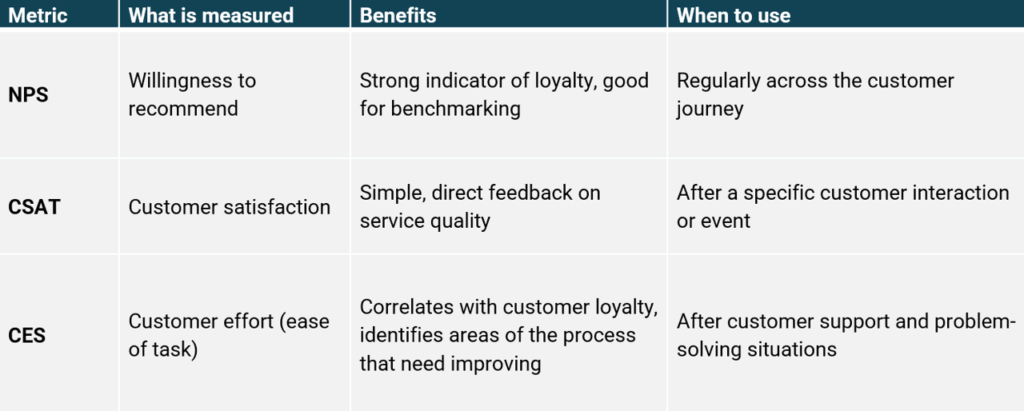
NPS, CSAT, CES? Choosing the Right Metrics for Customer Experience
Customer experience (CX) is the sum of every interaction a customer has with your organisation throughout their journey. It reflects satisfaction levels, service quality, the likelihood of recommendation, and the overall brand impression. A strong customer experience boosts competitive advantage, strengthens brand awareness, and drives loyalty.
CX is not a single moment – it’s a multi-dimensional process that begins with the very first interaction and lasts through the entire customer relationship. That’s why it’s essential to define how customer experience should be measured in your organisation and understand what the results reveal. Read more about why measuring customer experience is important.
Why Measuring Customer Experience Matters
Customer experience can be complex – and what isn’t measured can’t be improved. Identifying the right metrics and gathering insight at key stages of the journey allows you to make informed decisions that directly impact satisfaction and loyalty.
The Most Common Customer Experience Metrics – NPS, CSAT and CES
There are many ways to measure CX, but three key metrics stand out for their simplicity and effectiveness:
- Net Promoter Score (NPS)
- Customer Satisfaction Score (CSAT)
- Customer Effort Score (CES).
Each metric serves a different purpose and works best in specific contexts. Here’s how they compare:
NPS measures a customer’s willingness to recommend your organisation to others. It provides a quick and reliable snapshot of customer loyalty and is widely used across industries, making it a strong benchmark for comparison. NPS is best used regularly at various stages of the customer journey to track overall sentiment. However, it doesn’t reveal the reasons behind the score, so it’s important to include follow-up questions to gather deeper insights.
CSAT measures customer satisfaction with a specific product, service, or interaction. It’s ideal for gathering direct and actionable feedback immediately after a transaction or customer service event. CSAT helps you evaluate service quality and identify quick wins for improvement. While it offers valuable insight into individual experiences, it doesn’t reflect long-term customer loyalty or the broader customer relationship.
CES assesses how easy it was for a customer to complete a task or resolve an issue. It is particularly effective after customer support or problem-resolution interactions, as it highlights friction in service processes. CES has a strong correlation with customer loyalty and future behaviour, making it a valuable tool for process improvement. However, it does not capture emotional engagement or overall satisfaction, so it’s best used alongside other metrics.
Below is a summary of the most common CX metrics and how to use them:

How to Choose the Best Customer Experience Metrics for Your Organisation
To select the most effective customer experience (CX) metrics, start by clearly defining your measurement objectives: what do you want to learn, why does it matter, and how will you use the insights? There’s no one-size-fits-all solution when it comes to measuring CX — your choice of metrics and analysis methods should align with your organisation’s specific goals and priorities.
Before deciding which metrics to use, ask yourself these key questions:
What are your organisation’s goals for improving the customer experience? Do you want to improve customer loyalty, enhance customer service, or identify pain points in the customer journey? Having clear and consistent objectives will ensure that you choose the right metrics to monitor your customer experience.
Where in the customer journey do you want to measure the customer experience? Are you assessing the full customer relationship or focusing on a particular stage or touchpoint? It’s important to select the right metric for the right moment — using the wrong one can lead to a skewed understanding of your customers’ needs and perceptions
What insights are you hoping to gain, and how will they be used? Select metrics that support your goals and are easy to interpret, compare, and act upon. What matters most is that the data you collect enables you to make meaningful decisions that lead to a better customer experience.
By choosing the right metrics and applying them thoughtfully across the customer journey, you can gain a well-rounded, actionable view of your customer experience. For best results, combine NPS, CSAT, and CES at different touchpoints, and gather both quantitative data and open customer feedback throughout the journey.
Webropol helps organisations listen, understand and act on real-time information. Join thousands of satisfied Webropol users and start measuring customer experience with the right metrics, at the right time.